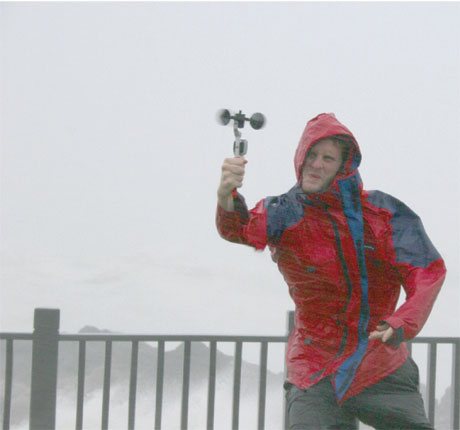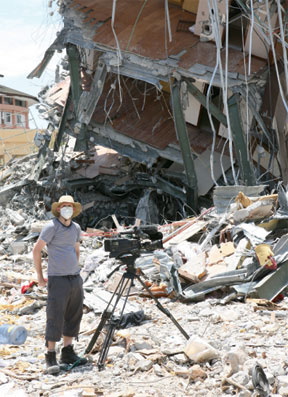Storm chaser
Updated: 2010-12-14 07:35
By Andrea Fenn(HK Edition)
|
|||||||
|
Reynolds taking wind measurements of typhoon Krosa in Taiwan in October 2007. Provided to China Daily |
Climate change continues to wreak havoc around the world, as storms become more deadly and natural disasters more destructive. To James Reynolds however, stormy weather is money in his pocket. Andrea Fenn reports.
"My job is 95 percent boring and 5 percent mayhem. Like any other job, there is also a lot of desk stuff to do," says professional storm chaser, James Reynolds.
Looking at his blog, it is immediately clear that the latter 5 percent of his job is what stands out. His website parades dramatic photos of super typhoons, volcano eruptions and flooded villages all around Asia.
Reynolds, 27, travels around Asia following typhoons and other natural disasters, shooting video and selling it to weather and news channels.
His work schedule has become busier and busier as the attention of the public turns increasingly to weather events and natural disasters become more destructive as a consequence of climate change.
Reynolds' passion for the forces of nature has deep roots.
|
James Reynolds at the ruins of the Ambacang hotel in Padang, Indonesia after an earthquake in September 2009. Provided to China Daily |
"I was always an outdoors guy, and loved geography at school," he says. "Besides, my father was a pilot so I always got to travel."
But it was not until 2005, when he was taking a Chinese language course in Taiwan, that he had his first real encounter with typhoons.
"There were several typhoons swinging by that season, and I accidentally found myself in their path," he recounts.
A year later, he bought a video camera and started uploading videos of storms on his blog, typhoonfury.com. Today, the website has become an established resource for weather and disaster reporting around the globe.
According to Reynolds, whenever big disasters hit, his website sees traffic increase by the thousands: as super typhoon Megi ravaged the Philippines in October 2010, Reynolds's site received over 4,000 hits per day.
Reynolds confidently maintains he is the only professional storm chaser in Asia. His status has brought him great popularity in the news industry, and from mere blogging he has started covering natural disasters in the region for news organizations.
Today, Reynolds is based in Hong Kong, which he finds a convenient hub for his trips around Asia. Several agencies frequently buy his videos, including CNN and US-based The Weather Channel.
"Now almost all my trips are covered," he says. "But of course, there are still times I end up without footage because the catastrophe does not happen or because I can't find a good place to shoot."
However, the thrill of confronting typhoons does not come without hardships.
Firstly, a storm chaser needs to establish expertise in the "field" in order to be able to make a living from it.
"Before the media considers you seriously and starts buying your stuff you have to build a portfolio," says Reynolds, "and that takes time and effort."
Besides, chasing storms around can be dangerous work. Reynolds says while areas like Hong Kong, Taiwan and the mainland are relatively safe to report disasters, countries with fragile infrastructure can be more hazardous.
"Once in the Philippines I found myself driving in the storm, with electric powerlines tangled in the vehicle, the street flooded and trees falling on the side," he recounts. "And what is worse, I got very little footage from that trip."
Storm-chasing trips require detailed preparation.
"First thing is to make sure that the natural phenomenon will hit land, and that it will be of a certain strength, so that it would be worth the trip," says Reynolds. "I would not want to make the effort of a trip just for a tropical storm."
To predict natural catastrophes, Reynolds uses a mix of scientific research and less conventional tools.
"I follow satellite images and official weather bulletins, and try to formulate my own idea of what will happen," he says. "At the same time, blogs are also a good source of information."
Roughly 24 hours before landfall, the moment when the impending catastrophe passes over the shoreline, Reynolds needs to get to the center of the storm. Four to six hours before, he has to choose a safe place to shelter and shoot the event.
"The philosophy I use is 'hide from the wind, run from the water'," says Reynolds. "Which means to stay as far away as possible from the water, the biggest threat, while shielding from the wind."
Once safely sheltered, finally "let the mayhem begin."
Among the memorable experiences he recollects, he lists Ambrym Island in Vanuatu, which boasts the very rare phenomenon of an open-air volcanic lava lake.
"It's like a giant lava washing machine of the size of two football fields," describes Reynolds. "The foremost juxtaposition of the fragility of humankind against the power of nature."
Sometimes, shooting these events can even be a pleasant experience.
"Once I was in Indonesia, shooting a volcano eruption from a beach nearby, lying under the sun and drinking beer," he says. "It felt a bit like a holiday."
Climate change and the attention it draws to natural events are increasing the need for a professional figure like Reynolds.
"Twenty years ago no one was reporting disasters, and many catastrophes in the developing world went unnoticed," he explains. "Because of all this talk about global warming, now there is more attention about weather change and weather events."
As climate change is likely to intensify natural cataclysms in the near future, Reynolds' job prospects seem rosy.
The World Meteorological Organization, the UN agency specializing in weather and climate issues, states that as a consequence of climate change, natural events are likely to become more intense and destructive in the years to come.
"By 2100, greenhouse warming will cause tropical cyclones to increase their intensity up to 11 percent," says WMO senior scientific officer Nanette C. Lomarda. "Meanwhile, rainfall within 100 km of the storm will increase by 20 percent."
According to Lui Wing Hong, Chief Experimental Officer at the Hong Kong Observatory, even in Hong Kong natural disasters are not an impossible occurrence.
"The last super typhoon crossing the territory of Hong Kong was Hope, in 1979," says Dr Lui. "That's why the chances of super typhoons hitting Hong Kong in the future cannot be ruled out."
Reynolds agrees, and is worried about the complacent attitude of Hong Kong people towards natural disasters.
"Hong Kong people are not prepared for it," says Reynolds. "If a super typhoon hit the city tomorrow, there would certainly be a lot of damage, and a lot of window replacement on all these skyscrapers."
Reynolds is just back from a long work trip in Indonesia, where he reported the disastrous eruption of volcano Merapi. But while he edits the piles of video he has collected, he is already looking at the horizon in search of ominous clouds.
"Cyclone season in Australia is ramping up soon," he says. "I will make sure I keep an eye on that."
|
Reynolds in Taroko Gorge, Taiwan during a violent flood in August 2007. Provided to China Daily |
(HK Edition 12/14/2010 page4)


